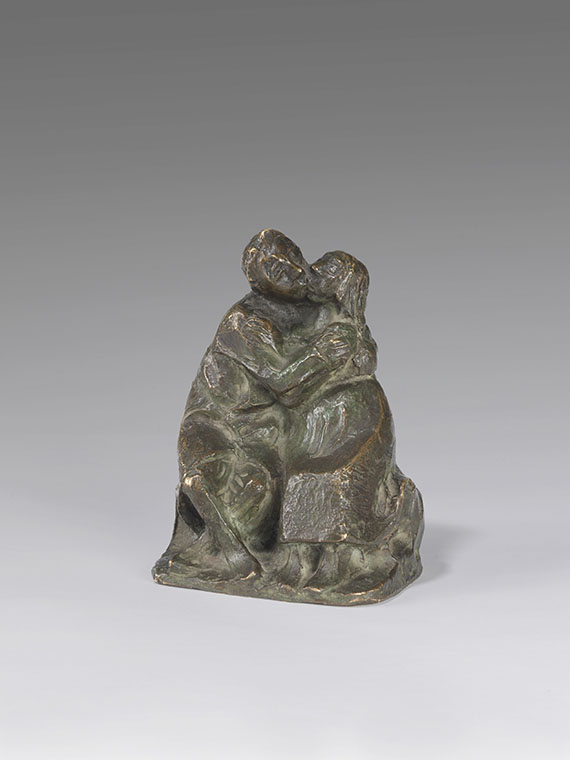Back side
26
Ernst Barlach
Kußgruppe III, 1921.
Bronze
Estimate:
€ 8,000 / $ 9,440 Sold:
€ 15,000 / $ 17,700 (incl. surcharge)
Kußgruppe III. 1921.
Bronze with brown green patina.
Lauer 326, Schult 255. With name in left and with foundry mark "H.Noack Berlin Friedenau" n lower right of plinth. One of 20 unnumbered copies from a partly posthumously made edition. 16,8 x 12,5 x 9,5 cm (6,6 x 4,9 x 3,7 in).
Cast in 1937/38 by art foundry Hermann Noack, Berlin. Rear of bronze open. [EH].
This thoroghly executed cast presumably is one of the first copies, made after the model from 1921.
We are grateful to the Ernst Barlach Lizenzverwaltung, Ratzeburg, for their kind expert advice.
LITERATURE: Bronzen von Ernst Barlach, Galerie Flechtheim, Berlin November 1930, no. 13. (presumably different copy).
Gemälde, Skulpturen, Environments vom Expressionismus bis zur Gegenwart, Museum Ludwig Köln, inventory catalog published by Siegfried Gohr, edited by Evelyn Weiss, Gerhard Kolberg, Cologne 1986 (presumably different copy).
The Northern German sculptor and graphic artist Ernst Barlach began his professional education in Hamburg, where he joined the Gewerbeschule in 1888. He continued in 1891 at the Dresden Akademie where he continued his studies of sculpture and became Robert Diez' master pupil. Barlach's thorough academic training was supplemented by two sojourns in Paris in 1895 and 1897. His work was further influenced significantly by a trip to Russia in 1909. The powerful and folk-like style of his sculptures reflect the artists impressions of sturdy rugged farm life and Russian folk art. Barlach also produced graphic illustration cycles for his own plays during this period. The artist settled in Güstrow (Mecklenburg) in 1910. Barlach had his first exhibition at Paul Cassirer's gallery in Berlin in 1917 and was accepted as a full member of the Preußische Akademie der Künste in Berlin in 1919. In the following years Barlach made numerous woodcuts, for example the illustrations for Goethe's "Walpurgisnacht". His autobiography "Ein selbsterzähltes Leben" was published in 1928.
The Preußische Akademie der Künste organised a comprehensive exhibition of his sculptures and graphic works in 1930. The artist was awarded the order Pour la Mérite in 1933. Even though Barlach was still able to complete the "Fries der Lauschenden" for Hermann F. Reemtsma and designed a grave monument for Theodor Däubler in 1935, he was soon defamed by the National Socialists. His works were banned from all museums, churches and public spaces in 1936. Today Ernst Barlach is considered one of the most important sculptors of modern times. Outstanding examples of his Expressionist figures in wood and bronze can be seen in the cathedral in Güstrow, the church of St. Elisabeth Marburg and in the National Gallery in Berlin.
Bronze with brown green patina.
Lauer 326, Schult 255. With name in left and with foundry mark "H.Noack Berlin Friedenau" n lower right of plinth. One of 20 unnumbered copies from a partly posthumously made edition. 16,8 x 12,5 x 9,5 cm (6,6 x 4,9 x 3,7 in).
Cast in 1937/38 by art foundry Hermann Noack, Berlin. Rear of bronze open. [EH].
This thoroghly executed cast presumably is one of the first copies, made after the model from 1921.
We are grateful to the Ernst Barlach Lizenzverwaltung, Ratzeburg, for their kind expert advice.
LITERATURE: Bronzen von Ernst Barlach, Galerie Flechtheim, Berlin November 1930, no. 13. (presumably different copy).
Gemälde, Skulpturen, Environments vom Expressionismus bis zur Gegenwart, Museum Ludwig Köln, inventory catalog published by Siegfried Gohr, edited by Evelyn Weiss, Gerhard Kolberg, Cologne 1986 (presumably different copy).
The Northern German sculptor and graphic artist Ernst Barlach began his professional education in Hamburg, where he joined the Gewerbeschule in 1888. He continued in 1891 at the Dresden Akademie where he continued his studies of sculpture and became Robert Diez' master pupil. Barlach's thorough academic training was supplemented by two sojourns in Paris in 1895 and 1897. His work was further influenced significantly by a trip to Russia in 1909. The powerful and folk-like style of his sculptures reflect the artists impressions of sturdy rugged farm life and Russian folk art. Barlach also produced graphic illustration cycles for his own plays during this period. The artist settled in Güstrow (Mecklenburg) in 1910. Barlach had his first exhibition at Paul Cassirer's gallery in Berlin in 1917 and was accepted as a full member of the Preußische Akademie der Künste in Berlin in 1919. In the following years Barlach made numerous woodcuts, for example the illustrations for Goethe's "Walpurgisnacht". His autobiography "Ein selbsterzähltes Leben" was published in 1928.
The Preußische Akademie der Künste organised a comprehensive exhibition of his sculptures and graphic works in 1930. The artist was awarded the order Pour la Mérite in 1933. Even though Barlach was still able to complete the "Fries der Lauschenden" for Hermann F. Reemtsma and designed a grave monument for Theodor Däubler in 1935, he was soon defamed by the National Socialists. His works were banned from all museums, churches and public spaces in 1936. Today Ernst Barlach is considered one of the most important sculptors of modern times. Outstanding examples of his Expressionist figures in wood and bronze can be seen in the cathedral in Güstrow, the church of St. Elisabeth Marburg and in the National Gallery in Berlin.
26
Ernst Barlach
Kußgruppe III, 1921.
Bronze
Estimate:
€ 8,000 / $ 9,440 Sold:
€ 15,000 / $ 17,700 (incl. surcharge)
Headquarters
Joseph-Wild-Str. 18
81829 Munich
Phone: +49 89 55 244-0
Fax: +49 89 55 244-177
info@kettererkunst.de
Louisa von Saucken / Undine Schleifer
Holstenwall 5
20355 Hamburg
Phone: +49 40 37 49 61-0
Fax: +49 40 37 49 61-66
infohamburg@kettererkunst.de
Dr. Simone Wiechers / Nane Schlage
Fasanenstr. 70
10719 Berlin
Phone: +49 30 88 67 53-63
Fax: +49 30 88 67 56-43
infoberlin@kettererkunst.de
Cordula Lichtenberg
Gertrudenstraße 24-28
50667 Cologne
Phone: +49 221 510 908-15
infokoeln@kettererkunst.de
Hessen
Rhineland-Palatinate
Miriam Heß
Phone: +49 62 21 58 80-038
Fax: +49 62 21 58 80-595
infoheidelberg@kettererkunst.de
We will inform you in time.




 Lot 26
Lot 26 
